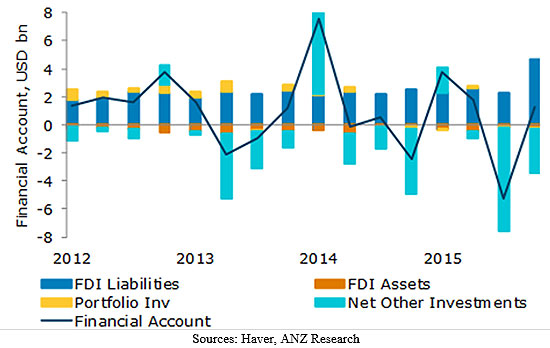Burgeoning offshore deposits no cause for alarm
 |
In the third quarter of 2015, the State Bank of Vietnam (SBV) revealed the offshore deposits under the other investment element in the balance of payments financial account, which added up to a massive $7.3 billion. Should one worry over such figure and Vietnam's foreign currency drain?
Indeed, the net other investment account in the BOP posted a significant rise in the outflow of $7.3 billion in the third quarter. However, on an annual basis, total net outflow in other investments reached $9.1 billion in 2015, after the slow down in Q4. While the outflow in Q3 seems oversized, it is not unusual. Given that the tendency slowed down in Q4, in our view, the risk of sustained deposit outflow has eased. Now that the upside pressure on the USD/VND rate has been eased, we see little risk of further capital outflow.

Although the central bank said that it was normal for the offshore deposits to be boosted to $7.3 billion, as the result of the Chinese yuan devaluation last August and expectation over a Fed rate hike last September, do you think it was normal practice for local banks to make overseas deposits, to ensure high liquidity across the local banking system?
The surge in outflow in Q3 to $7.3 billion could have been triggered by the unexpected devaluation of the CNY and the subsequent devaluation of the USD/VND rate. At the time, the upside pressure on the USD/VND rate was still strong, so the risk off sentiment was unusually high. Since the start of 2016, the trade balance has been posting a year-to-date surplus and the expectation of a delay in Fed hikes has taken the pressure off the USD/VND rate. However, the 0 per cent cap in deposit rates in USD accounts will temper USD deposits’ return to Vietnam.
While the local government yearns to issue some $3 billion worth of international G-bonds, why would it not issue through Vietnamese commercial banks to take advantage of the $7.3 billion available in offshore deposits?
By issuing international bonds to tap into global resources, the government is diversifying its sources of funding. It also ensures that the local credit market is not crowded out by government. In case these offshore deposits come back to Vietnam, USD liquidity may be used to finance the needs of the local market.
What the stars mean:
★ Poor ★ ★ Promising ★★★ Good ★★★★ Very good ★★★★★ Exceptional
Latest News
More News
- Tax sector wraps up 2025 and sets priorities for next year (December 25, 2025 | 14:00)
- A tipping point for digital and hybrid wealth management in Vietnam (December 23, 2025 | 13:33)
- $250 million deal targets women-owned SMEs, sustainable agriculture (December 22, 2025 | 17:40)
- Stock market posts resilient 2025 performance (December 19, 2025 | 18:17)
- Citi Vietnam receives 2025 AmCham CSR recognition (December 19, 2025 | 16:35)
- As global green supply chain reshapes, will Vietnam be left behind? (December 19, 2025 | 08:00)
- Banks gear up for massive capital increases (December 18, 2025 | 17:04)
- Securing capital and efficiency for Vietnam’s 2026-2030 growth ambitions (December 17, 2025 | 10:00)
- Energy sector in need of blended finance mechanisms (December 17, 2025 | 09:00)
- Vietnam still has room to mobilise capital for sustainable growth (December 17, 2025 | 08:57)
















 Mobile Version
Mobile Version